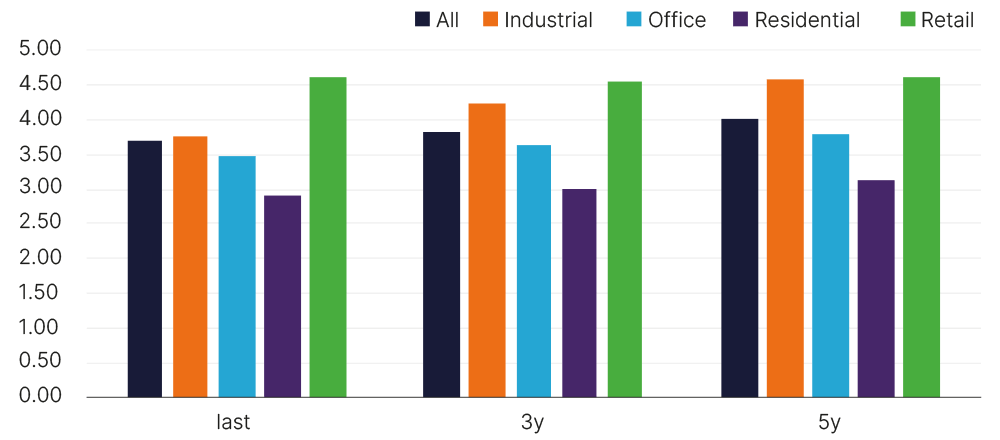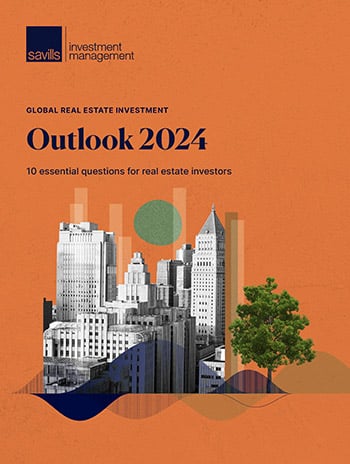If we stick with the image of “therapy”, then psychologists speak of distinct phases in facing crisis: shock, depression, acceptance, coping. We suggest that bricks-and-mortar retail has found its way to ‘coping’; indeed, the deluge of news around uncertainty and fear appears to have moved on.
Retail capital values have fallen strongly in recent years, indeed MSCI records a further 17% fall in capital values across Europe in 2022 with more likely recorded as 2023 ends.
Some investors have yet to reach the acceptance phase, but for us, we like the high income return that retail offers, with parts of the market supported by compelling fundamental drivers. Retail has moved from being one of the lower income sectors to the highest.
Of course, the recent years have been a challenge through structural and cyclical issues, we believe that the structural challenges (sales diversion) are clear and that the cyclical challenges (cost of living) will repair over 2024 and beyond.
This has different implications for the various parts of the retail sector and investors should recognise the breadth of risk and opportunity.
Footfall in Europe’s main retail destinations has returned strongly.
City Centres and Shopping Centres
The growth of e-commerce continues to dilute comparison spending through physical shops and has a disproportionate impact upon stores’ profit levels – and thus rent affordability. Consequently, retailers still seek to reduce their rent bill through closures and negotiation with the landlords, and this challenges the values of non-prime destinations.
But we see some signs of stabilization, specifically for absolute prime locations. Indeed, in the US, e-commerce growth has eased off materially in recent months. It is easily forgotten that shopping is predominantly a store-based activity, and for those central, accessible, amenity-rich locations, retailers are once again competing for the best space attracting the high footfall for the retail therapy that consumers still enjoy. It might just be anecdotal for now, but we sense footfall in Europe’s main retail destinations has returned strongly, consumers enjoying the therapy of physically shopping in compelling, diverse, and entertaining retail environments. Of course, the target investment markets are much reduced, and investors need to be more forensic than ever around specific locations.
We also recognise revitalised urban neighbourhoods, benefitting from the mix of convenience, amenity and the opportunity of mixed use that spans retail, office, leisure and of course residential. The opportunity to create or own such mixed-use real estate is increasingly catching our attention as income streams are robust, diversified and supported by the fundamental growth of our cities. If investors could recognise the value of such mixed-use properties, we are confident of rewarding returns.
Convenience and necessity
We have deep experience in the routine and convenience-orientated retail segments, namely supermarkets and retail parks. Not only are supermarkets supported by financially robust tenants readily signing long and secure leases, but being value orientated, they have typically thrived in this weaker economic environment. The retail stores’ role as part of the multi-channel supply chain adds to the attraction and, with potentially high alternative-use value related to ongoing urban population growth, the downside risks are lessened.
The therapists looking out to 2024 and beyond should guide that retail is detail; investors will welcome the robust income streams available but caution the ongoing challenges for the necessarily intense management requirements of mainstream shopping centres and mid-market shops in off prime locations in towns and cities.
Figure 10: Retail is now real estate’s high yielding sector

Sources: MSCI Europe Annual Property Index (Unfrozen; Weighting: Market Size) published Annually, here 14. April 2023
SUPERMARKET CHECK LIST
Shopping for Supermarkets
- Long leases
- Indexed rents
- Robust tenants
- High adaptability for what is sold
- Part of last mile delivery
- Accessible and appealing to consumers
- Limited obsolescence
- High alternative use value
- Fair pricing
“The length and quality of supermarket income streams is a compelling part of the real estate investment landscape and investors have recognised its appeal”
IAN JONES
Investment Director, Savills Investment Management, September 2023
